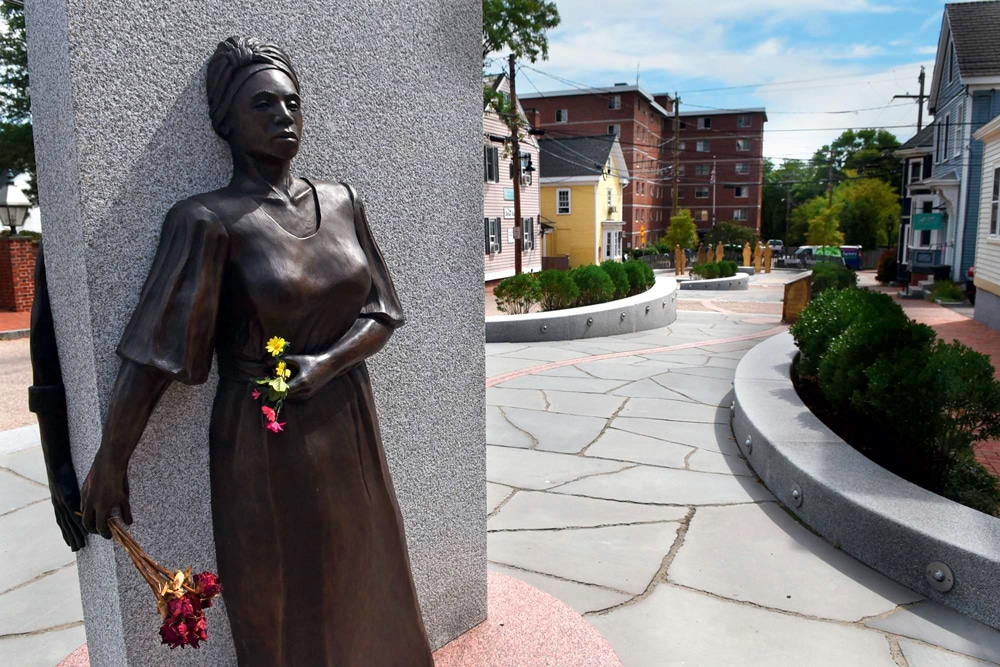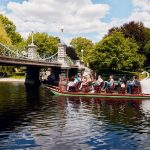The Best 5 Windows on Black History
Long-untold stories come into unforgettable focus at these New England sites.

Coffee By Design | Portland, Maine
Photo Credit : Katherine KeenanFor New Hampshire author and historian Valerie Cunningham and Boston-based artist and educator L’Merchie Frazier, giving voice to the experiences of Black New Englanders is a constant quest—not just a 28-day exercise every February when Black History Month comes around. Their work uncovering and interpreting artifacts, documents, and even a burying ground enriches the American narrative and makes New England a significant destination for learning about African-American culture and contributions. They are our guides, as we spotlight five engaging places that may well leave you asking: Why have I not heard this history before?
African Burying Ground and Black Heritage Trail Portsmouth, NH
An artful and moving place to confront the reality of slavery in colonial New England, the African Burying Ground Memorial Park honors nearly 200 souls whose gravesites were paved over and built upon as Portsmouth grew. For Cunningham, the park’s dedication in 2015—after archeological and DNA testing confirmed this to be New England’s only known 18th-century cemetery for free and enslaved Africans—capped work she had begun in the 1960s to identify and highlight landmarks.

Photo Credit : ©Deb Cram–USA Today Network (Memorial)
Take a self-guided tour of 23 additional sites along the Portsmouth Black Heritage Trail, which Cunningham founded, or choose a themed guided tour offered by the expanded organization she still serves, the New Hampshire Black Heritage Trail. At 80, ever a crusader for the long-forgotten, she’s meticulously researched the newest tour, inspired by the movie Green Book. blackheritagetrailnh.org
Rokeby Museum Ferrisburgh, VT
A 90-acre farm that was home to four generations of Robinsons from 1793 until 1961, Rokeby Museum provides “an excellent explanation of what the Underground Railroad really was, not all the mythology,” Cunningham says. Historical letters shed rare light on the clandestine operation that funneled escaped slaves northward. Via visual and theatrical audio presentations in the education center, you’ll meet two fugitives from slavery, Simon and Jesse, and trace their 1830s journey to safe haven at Rokeby, where the abolitionist Quaker farmers didn’t hide them—they employed them. Next, tour the home, outbuildings, and grounds where Merino sheep were grazed, and dive deeper into the true story of how freedom seekers became part of the fabric of New England farm life. rokeby.org
Museum of African American History Boston, MA
The largest, most powerfully affecting assets in the Museum of African American History’s collection stand side by side on Beacon Hill: the 1806 African Meeting House, America’s oldest surviving Black church, and the Abiel Smith School, which was the first school built, in 1835, specifically for Black children. Two of the nation’s oldest buildings crafted by and for those of African descent, they “represent intentional effort to gather, to own, and to project themselves as people of value, worth, and contribution,” says Frazier, the museum’s director of education and interpretation. Among the 5,000-plus objects in the museum’s collection is a 1773 first edition of poems by Phillis Wheatley, the first published African-American author. Each artifact and artwork is a revelation “about American history and the contributions of Blacks in that history,” she says. maah.org
New Bedford Historical Society, Whaling National Historical Park, and Whaling Museum New Bedford, MA
Frederick Douglass arrived in New Bedford a fugitive from slavery. He departed three years later, in 1841, a self-made man on the cusp of oratorical fame. His time in this cobblestoned town coincided with the peak of its whaling fortunes, and Cunningham says most people “are just not aware” of Black mariners’ role in the early American economy, nor of the Quakers and free people of color who made New Bedford a popular terminus on the Underground Railroad. Separately and in collaboration, New Bedford Historical Society, New Bedford Whaling National Historical Park, and New Bedford Whaling Museum strive to bring this history to the fore.

Photo Credit : Kathryn Roy/StayingAfloatBlog.com
At the museum, you’ll meet abolitionist Captain Paul Cuffee, who was of African and Native American descent, and the community of Cape Verdeans who emigrated to New Bedford seeking opportunities. The national park’s guide to Underground Railroad sites invites you to navigate further on your own, as does the Black History Trail created by the historical society. And keep your eyes peeled for standout murals around town that pay homage to Frederick Douglass, the 54th Massachusetts Volunteer Infantry Regiment, and local jazz greats. nbhistoricalsociety.org; nps.gov/nebe; whalingmuseum.org
Abyssinian Meeting House and Portland Freedom Trail Portland, ME
America’s third-oldest intact African American meeting house is the crowning jewel, says Cunningham, of the 13-stop Portland Freedom Trail. Built in 1828 by Black artisans on land provided by African-American abolitionist and Underground Railroad conductor Reuben Ruby, the timber-frame structure was saved by Ruby’s quick-thinking son from the Great Fire of 1866, which destroyed much of the coastal city. Today a restoration in progress, it is envisioned to once again become a hub of culture and discovery. From Franklin Street Wharf, where anti-slavery activists met stowaway slaves and ensured their safe passage to Canada, the two miles of the Freedom Trail extends to the former site of Mariners’ Church, where Daniel Colesworthy operated an anti-slavery bookshop and published the first Afrocentric history of the world. abyssinianmeetinghouse.org; portlandmaine.gov







